Insurgent Validation Stamps
by Max A. Keech
The Insurgent validation stamps are much more diverse and uncertain than the Royalist issues. There is virtually no contemporary documentation to support assignment of these issues and what we know today is primarily Pradeau’s speculation based on his observations first published in 1938A. F. Pradeau, Numismatic History of Mexico from the Pre-Columbian epoch to 1823. New York, 1938. The fact that this still stands after 75 years speaks to his monumental efforts which covered the entire numismatic history of Mexico. In this article I will attempt to update some of that work, based on a close analysis of the coinage itself.
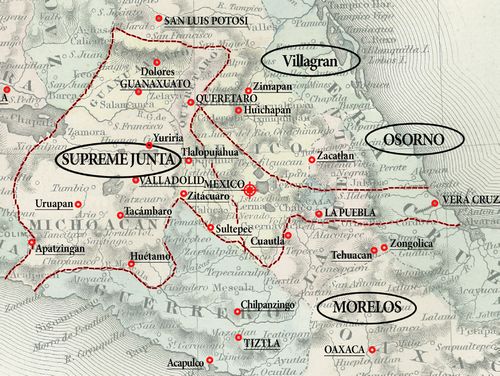
Insurgent authority 1811-1812
To understand the various Insurgent issues it is informative to distinguish the four different authorities/geographies in central Mexico from 1811 to 1814. The Supreme Junta was in theory the governing body of all insurgent forces since its formation on 19 August 1811. On the ground, however, it was dominant over only the northern and western portions comprising the insurgent stronghold of Michoacán. Morelos swore allegiance to the Junta and there was constant communication, interaction and the sharing of resources between Morelos and President Rayón and the Junta, at least thru late 1812, but Morelos was always in control of the south. Morelos’ theater of operation included the provinces of México (including present day Guerrero), Puebla and Oaxaca. The independents Villagrán and Osorno operating in the eastern highlands, north of Veracruz, swore allegiance only to themselves and profit. The Supreme Junta and Morelos both issued struck, as well as cast, coinage in large quantities during the period between 1811 and 1814. They also independently counterstamped provisional/necessity issues circulating in their jurisdiction.
Once we distinguish mint casting stamps from counterstamps, we realize that the casting stamps are smaller in number and somewhat easier to place in chronological sequence and issuing authority. Each of the four Insurgent jurisdictions produced cast coinage and each, at least for their earliest casts, used mint casting stamps. Counterstamps are more challenging and the challenges occur within the Supreme Junta geography and jurisdiction (Michoacán). This is because the majority of the counterstamp issues occur here and the authority is confusing. The reasons are twofold.
First, the provisional mints and hence the provisional coinage were in Michoacán and areas north, primarily Zacatecas. If you concur that only provisional coinage was counterstamped then it follows that the counterstamps will occur where the provisional coinage circulated and this is Supreme Junta geography. In the south under Morelos’ control there was little provisional coinage. The dominant circulating issue would be the fine and trusted coinage of Mexico City and this did not require validation. The proof of this “rule” is the extreme rarity of valid examples of counterstamps on Mexico City coinage. Morelos did counterstamp provisional/necessity coinage including a wide variety of issues that made their way south. However, the majority of the coinage that Morelos counterstamped was the dominant circulating provisional coinage in the South and this was his own copper SUDs! Similarly, in the eastern highlands under Villagrán and Osorno’s sway provisional coinage was not abundant and here we do not find valid counterstamps at all, just their casting stamps (at least as it relates to 8 reales).
Second, in late 1812 the Supreme Junta’s authority (as expressed thru its President, Ignacio López Rayón) began to disintegrate and by early 2013 Insurgent leadership in Michoacán was fractured. This resulted in a host of independent chieftains, some of whom undertook independent counterstamping operations. In these cases identifying the issuing authority can be difficult.
After considerable study, I am convinced that organizing these issues by their four areas of authority and then trying to place them chronologically is a necessary approach to their correct attribution. This new approach sacrifices the traditional alphabetical simplicity for the promise of discovery. To my knowledge, there have been no past attempts at placing the validation stamps in sequence. So please accept this as a first step as we start with the most challenging issues of the Supreme Junta in Michoacán.
Methodology
In the area under the Supreme Junta’s jurisdiction there was significant coinage circulating from the provisional mints of Zacatecas and Guanajuato, whereas there was little provisional coinage in Morelos’ territory (the Oaxaca provisional issue was quite small). Consequently, Supreme Junta counterstamps are predominantly found on northern provisional issues while Morelos counterstamps occur on a wide diversity of provisional issues of both Royalist and Insurgent origin. For issues of uncertain authority this geographical association is useful in identifying what jurisdiction or region issued a particular counterstamp. If the stamp has a diverse and relatively equal mix of host coins, then it probably emanates from Morelos’ jurisdiction in the South. On the other hand, if the host coins of a particular counterstamp are predominantly of Zacatecas and Guanajuato origin, then it is likely to be an authority within the Supreme Junta’s geography. The dates of the host coins also tell a lot about when the validations may have taken place. While these dates do not tell you when a series started, they do tell you when their use ceased. The concentration of any particular year for the hosts also points to when the validation was issued. For instance, in mid-1813 a high percentage of the circulating provisional coins would be dated 1811 and 1812 (as well as 1813) so even for a 1813 counterstamp we would expect perhaps half of the hosts to be dated in prior years. While I do not know if half is the correct figure, it is reasonable to assume that validation stamps containing a higher percentage of latter hosts were validated later than stamps with earlier host populations. This same methodology applies for mint casting stamps. Here the cast coinage was produced from Mexico City Mint madres. If we have a reasonably large population to analyze, the latest dated coins and their percentage of the total gives us a good indication of when they were cast (or at least when casting ceased).
Utilizing this “distribution of hosts” I have attempted to list chronologically the Insurgent validation stamps by issuing authority rather than alphabetically. I have also attempted to provide an overview of a few key historical events to give these assignments context. In doing so, I am often in conflict with Pradeau (and hence most subsequent references) on many issues. This is an uncomfortable and risky undertaking that causes me much hesitation. I also believe it is the next step forward and I think Dr. Pradeau would approve. We have much available to us today that simply did not exist in Pradeau’s time including 75 years of auction catalogs and the ability to search virtually anything on the internet. In analyzing the host coins of the various validation stamps I have utilized a population from all major references and auction catalogs as well as my own collection and observations. In addition, I would like to acknowledge the assistance of Mike Dunigan and Don Canaparo, each of whom has graciously shared their own specimens and data collected over many decades. Together, I believe these coins tell their own story and sometimes it is simply different than what we have heard before. I anticipate these assignments will be the subject of some skepticism, additional revision and perhaps disagreement. I welcome your input as the work has only started.
SUPREME JUNTA, United then Divided
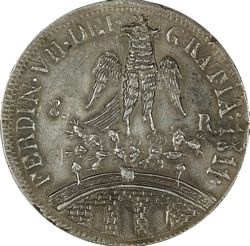
Supreme Junta 1811 8 reales
The Supreme Junta was established by a congress at Zitácuaro on 19 August 1811. The Junta elected Ignacio López Rayón as president, together with José María Liceaga and José Sixto Verduzco as Junta members. Morelos did not attend the Congress but, rather, sent Verduzco as his representative. From the initial establishment of the Supreme Junta Rayón endeavored to establish a functioning government, with its own departments and armies including trappings such as a printing press, and its own coinage. The first coinage of the Supreme Junta was the 1811 issue with a raptor on nopal cactus seated on a bridge on the obverse and a series of native arms on the reverse. I discussed this first issue in depth in “The First Issue of the Supreme Junta of Zitácuaro and Theories on Early Mexican Symbolism” in the March 2012 journal. Zitácuaro represented the Insurgent capital until the Junta was expelled by Royalist forces under Calleja in January 1812.
The next “Capital” was established at Sultepec. In June 1812 the three leaders were forced to abandon Sultepec and split their forces into three separate commands. This was done to avoid congregating their forces and offering a single military target for Royalist adventure. Rayón set up the new Insurgent capital at Tlalpujahua. Liceaga was placed in charge of the northern military command and moved his forces to Guanajuato (and later Yuriria Island). Verduzco commanded the Supreme Junta’s southern forces from Huétamo. From the establishment of the Supreme Junta in Zitácuaro in August 1811 until late 1812 the Insurgents’ northern command was unified under President Rayón and Junta members Liceaga and Verduzco. After the separation of the Junta members and as military setbacks occurred the previous harmony turned to backbiting. By late 1812 the northern Insurgent alliance was dissolving and each began operating independently of the others. Rayón was incensed that Liceaga and Verduzco would not submit to his presidential authority and in particular cited Liceaga’s insubordination. On 30 January 1813, in an act of complete defiance, Verduzco and Muñiz attempted to overrun Valladolid with a force of 15,000 men. Rayón had not approved the attack but, rather, had ordered them to wait for his forces to ensure success. Verduzco and Muñiz’s forces attacked anyway and were thoroughly routed by Lt-Col. Antonio Linares, Royalist commander of Valladolid (the Linares counterstamp is discussed in Part 1). By February Verduzco and Liceaga were in full revolt, claiming sovereignty of the Supreme Junta resided in them. Rayón called for their arrest: Liceaga and Verduzco declared Rayón a traitor. Only the intervention of Morelos prevented all out armed conflict.
Supreme Junta mint casting stamp, 1811 – early 1812
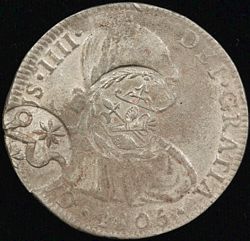
Supreme Junta & Morelos mint casting stamps
In my opinion this is the first mint casting stamp of the Supreme Junta. The stamp features a replica of the native arms (bow, arrows, sling, javelin and quiver grouped together) depicted on the Supreme Junta coinage. This stamp is only found as a casting stamp. It is not found as a counterstamp used to validate circulating provisional coinage. Pradeau and all subsequent references assign this to Chilpancingo after the Congress of 13 September 1813 and it is traditionally referred to as the “Chilpancingo A” counterstamp. No support for this assignment was provided by Pradeau and, to my knowledge, any subsequent authors. I believe both this and the supposed “Chilpancingo B” stamps belong to the Supreme Junta and were utilized almost two years earlier than previously reported. There are three compelling reasons to place this issue with Rayon’s Junta in 1811 and not the Congress in late 1813:
1. The hosts, or casting madres (models) tell us that this issue was primarily cast in 1811 and that casting concluded in early 1812. Casts showing a Ferdinand VII draped bust (which began being produced in Mexico City in late 1811) are rare and I am only aware of two examples bearing a date of 1812 with no examples dated 1813 or later.
2. The imagery of the stamp is identical to that of the Supreme Junta’s which was created following formation of the Junta on 19 August 1811 and immediately appeared on both struck and cast Junta coinage.
3. By 1812 both the Supreme Junta and Morelos were casting coinage of their own designs. It does not seem logical that in late 1813 they would revert to casting money with the King’s portrait when it was just as expedient to cast their own. It is also unlikely that Morelos would proclaim for the King after the initial months of insurrection and his casting stamp is contemporary to the Junta’s.
This casting stamp is often found in combination with a Morelos and/or Lva casting stamps. Why would the Insurgents begin applying sometimes one, sometimes two and often three casting stamps to the same cast coin? In the first year of the Junta’s formation all the insurgents with the exception of the independents Osorno and Villagrán were united as a common revolutionary government. This certainly included Morelos’ forces who were in constant communication with Rayón and who shared resources, including money. It seem probable to me that these stamps were meant to designate an insurgent group that participated in acquiring a shipment of silver or was for other reasons intended to share in it when casting was complete. The stamp or stamps were intended to designate ownership. The Supreme Junta, Morelos and Lva stamps were related and all were produced in this 1811 to early 1812 period. The relationship probably involved geography. At least 50% of the Junta casts bearing the Supreme Junta stamp also contain a Morelos casting stamp. The Supreme Junta stamp was likely used south of Zitácuaro in areas under joint operation with Morelos. The Supreme Junta also cast silver coinage of the struck “raptor on bridge” design pictured above in Zitácuaro in 1811. This overlap is what leads me to believe the casting stamp might have been utilized elsewhere by the Junta.
The Supreme Junta and Morelos stamps provide clear identification but who did the “Lva” stamp represent during this early period? The “Lva” mint casting stamp is rarely found by itself. It almost always occurs in combination with the Supreme Junta stamp, the Morelos stamp or both. In my opinion no reasonable assignment has yet been offered for the “Lva” stamp. Some (including myself) believe the stamp may have been inverted when cataloged by Pradeau and should be read as “Ta” or “Tva” instead. For a lively discussion of this topic, I would refer the reader to Sociedad Numismática de México bulletins 165-170 published in 1994-95.
Supreme Junta counterstamp, Ensaie, 1811 – January 1812
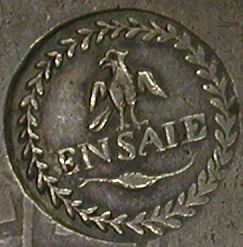 I believe this to be the first counterstamp of the Supreme Junta at Zitácuaro. The counterstamp consists of the word “ENSAIE” (Assay) under a raptor and above a native sling surrounded by a circular wreath of “arrow points”. This stamp incorporates key elements of both the obverse and reverse of the first Supreme Junta coinage of 1811: you will immediately recognize the resemblance of the raptor. It is almost always found on Zacatecas hosts. Most are of the LVO type and are dated 1811 with a few dated 1810. There is one, or perhaps two, outliers on Zacatecas hosts dated 1812. Interestingly, there are at least eight different punches of this type indicating wide use over a short period of time. The punches differ primarily in the direction and style of the arrow points. This attribution is consistent with the Supreme Junta’s first residence in Zitácuaro from 19 August 1811 thru 2 January 1812. Given the number of punches used over this 4½ month period, it seems reasonable to infer that they were used in Zitácuaro and many other areas under the Junta’s control. None of the other Insurgent counterstamps exists on such an early density of hosts, lending considerable support to my theory that these were the first and probably only counterstamp used while the Junta resided in its first capital of Zitácuaro. The lack of use after 1811 could indicate that most of the punches were lost or destroyed in the Junta’s hurried evacuation to Sultepec ahead of Calleja’s army. The 1812 outlier(s) might be explained by a surviving punch, perhaps elsewhere in surrounding Michoacán? In any event, its use barely saw 1812.
I believe this to be the first counterstamp of the Supreme Junta at Zitácuaro. The counterstamp consists of the word “ENSAIE” (Assay) under a raptor and above a native sling surrounded by a circular wreath of “arrow points”. This stamp incorporates key elements of both the obverse and reverse of the first Supreme Junta coinage of 1811: you will immediately recognize the resemblance of the raptor. It is almost always found on Zacatecas hosts. Most are of the LVO type and are dated 1811 with a few dated 1810. There is one, or perhaps two, outliers on Zacatecas hosts dated 1812. Interestingly, there are at least eight different punches of this type indicating wide use over a short period of time. The punches differ primarily in the direction and style of the arrow points. This attribution is consistent with the Supreme Junta’s first residence in Zitácuaro from 19 August 1811 thru 2 January 1812. Given the number of punches used over this 4½ month period, it seems reasonable to infer that they were used in Zitácuaro and many other areas under the Junta’s control. None of the other Insurgent counterstamps exists on such an early density of hosts, lending considerable support to my theory that these were the first and probably only counterstamp used while the Junta resided in its first capital of Zitácuaro. The lack of use after 1811 could indicate that most of the punches were lost or destroyed in the Junta’s hurried evacuation to Sultepec ahead of Calleja’s army. The 1812 outlier(s) might be explained by a surviving punch, perhaps elsewhere in surrounding Michoacán? In any event, its use barely saw 1812.
Pradeau did not attempt to assign this issue beyond identifying it as of the Insurgent army.
Supreme Junta counterstamp, 1812 – 1813
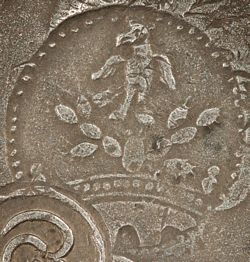
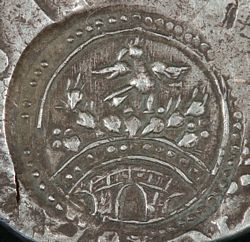
Supreme Junta Raptor on Bridge (incorrectly cataloged as Chilpancingo)
The reader will probably know this counterstamp as an issue of Chilpancingo following the Congress of 13 September 1813. I believe this attribution to be incorrect and would suggest it be assigned to the Supreme Junta while under Rayon’s command 18 months before the Congress. Based on an analysis of hosts, the counterstamp coincides with the Junta’s united command at Sultepec and Tlalpujahua. The stamp presents a raptor on a nopal cactus on a three-arched bridge. This stamp is clearly designed to mimic the obverse of the Supreme Junta’s coinage. There are approximately ten different punches of the Supreme Junta design with the most common hosts being the 1811-12 coinage of Zacatecas and the 1813 bust 8 reales of Guanajuato. This 1/3, 1/3, 1/3 distribution is consistent with a concentrated use in Michoacán (the Supreme Junta’s geography) in 1812 and 1813. It appears to be the primary counterstamp of the Supreme Junta prior to its splintering and also of Rayón’s forces following this event.
Pradeau first described this (and the preceding Supreme Junta casting stamp) as being created at the Congress of Chilpancingo. Chilpancingo is located in the current state of Guerrero, far from the provisional mints of Zacatecas and Guanajuato. The Congress first met there in September 1813, after the fall of Tlalpujahua (March 1813) and the second fall of Zitácuaro (September 1813). The Congress transferred executive powers from Rayón to Morelos and declared independence from Spain. Morelos’ battlefield adventures from this point soured and by January 1814 the fleeing Congress returned authority to Rayón along with Cos and Rosains. The Insurgents were in steady decline. Pradeau does not offer any support for his Chilpancingo Congress assignment. It has being repeated ever since in virtually every reference book and auction catalog and this is where you will find it in Krause today. In my opinion this attribution is impossible based on the host coins and the stamp itself. The issue is somewhat common and, given its numbers, could not have occurred in the brief period from September 1813 to the end of that year. In addition, we only find it on 1811-13 northern hosts and not on provisionals of the south and coast such as SUDs, Oaxaca or Villagrán. Finally, the stamp’s symbolism speaks for itself in identifying the Supreme Junta’s authority.
SUPREME JUNTA Divided, late 1812 – 1813
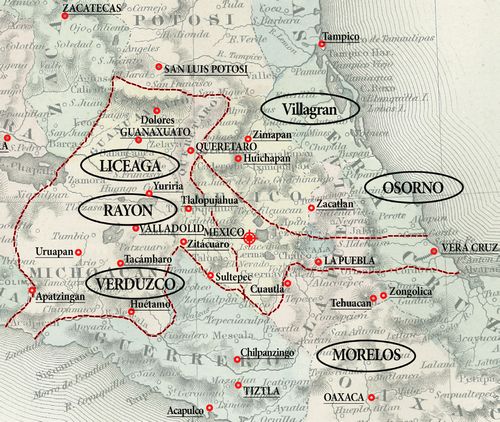 Insurgent Authority, 1813
Insurgent Authority, 1813
From late 1812 onwards Liceaga, Verduzco and numerous sub-commanders acted independently, running their own commands similar to Osorno and Villagrán in the east. This occurred even though Rayón and the Junta continued to run the insurgent government and even strike significant amounts of coinage in Tlalpujahua. This is the key event that explains the large number of later, mostly unidentified northern counterstamps. It is at this time that we see independent stamps such as JML (José María Liceaga) first appearing. Many of the unattributed Insurgent counterstamps are found almost exclusively on northern hosts of latter average date. Nothing similar occurs in the south and east. Morelos, Osorno and Villagrán’s leadership remains unchallenged until they are subdued by the Royalists and we do not find competing issues. It is hard to imagine Liceaga, Verduzco or any sub-commander counterstamping or casting their own coinage before this split. We will now examine two of the divided Junta issues, saving the remainder for future articles.
José María Liceaga, Independent Chieftain, late 1812 – 1813
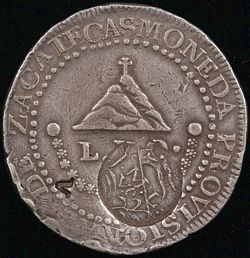

Zs 1811 LVO with JML counterstamp JML counterstamp enlargement
Almost certainly acting as an independent chieftain in late 1812, José María Liceaga began counterstamping provisional/necessity issues under his own name. The Liceaga counterstamp consists of the initials J.M.L. across a staff and flag above two olive branches(?). Below J.M.L. is a subscript of two to three letters. Liceaga was quite a self-promoter, so it is no surprise that his counterstamp consisted of his initials. About ten different sets of subscripts are known, often with a capital letter followed by small letters. As yet we do not know what they mean. Like alphabet soup, many a numismatist (including this one) has tried to align these subscripts with sub-commanders or cities under Liceaga’ s jurisdiction. Can you be the first to solve this puzzle?
Host coins with the JML counterstamp are predominately Zacatecas and Guanajuato provisional issues. About a third of all these counterstamps occur on the very scarce 1813 Guanajuato 8 reales. There are more than 20 different punches displaying the JML stamp making this issue somewhat common. Some of the individual subscripts, however, can be quite challenging to locate.
Pradeau correctly assigns this issue to Liceaga but reports that the counterstamps were used during Liceaga’s stay on Yuriria Island from 9 September to 31 October 1812. Pradeau supported this assignment with historical accounts that indicate coinage activities occurred during Liceaga’s stay. The problem with this assignment is the short period involved, given the surviving population of JML counterstamps. Even more damaging is the large number of 1813 Guanajuato hosts which were minted post-Yuriria. As an alternative I would suggest that Liceaga used the JML counterstamp after his separation from President Rayón in late 1812.
Supreme Junta Army of the North, 1813
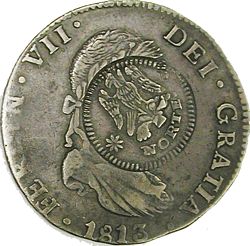
Go 1813 8 reales with NORTE counterstamp
The Army of the North counterstamp consists of the word NORTE below a raptor of stronger and more militarized style than the Junta stamp previously seen. To the left of the raptor is an eight-pointed star and to the right a small fleur-de-lis in the crenulated border. There are two other Norte types: one has the star in the right field and no fleur-de-lis, the third has the initials M.L.N. replacing NORTE and a fleur-de-lis in each field. The most common host for the Norte counterstamp is the 1813 issue of Guanajuato. This host represents about 50% of the known examples with the remainder on 1811-12 Zacatecas coins. Given the higher percentage of 1813 dated hosts is it probable that this counterstamp was used only in 1813 and was one of the last Insurgent stamps? Pradeau assigns this to Rayón and that is probable but not certain. We find examples of this scarce stamp over both JML and Supreme Junta stamps. This creates a couple of interesting possibilities. Following the breakup, Liceaga and Cos established themselves in separate locations within the Bajio (lowlands) of Guanajuato. Shortly thereafter, Rayón sent his brother Ramón into this region to both recruit and counter Liceaga and Cos’ influence. Given the “NORTE” proclamation it seems probable that Rayón’s divided Junta utilized the Norte stamp as part of their outreach into the Guanajuato Bajio, either as a replacement of the Junta “Raptor on Bridge” stamp or concurrently. There is also a small possibility that Cos could have used this stamp while the Junta continued with the “Raptor on Bridge” stamp.
José María Morelos
Morelos operated somewhat independently from the Supreme Junta. In 1811 Morelos controlled much of coastal Michoacán and what is now Guerrero. In mid-1811 he was headquartered in Tixtla near Chilpancingo and it is believed that he first started coinage with the copper SUD issue about this time in Tixtla. Morelos was in constant communication with the Junta, at least thru mid-1812 and resources, including money, were shared. Morelos occupied Cuautla on 24 December 1811. From this time until 2 May 1812 his forces were trapped in Cuautla under siege by the Royalist army under Calleja. Morelos was forced to flee the siege and barely escaped. It is believed that Morelos did not issue coinage while in Cuautla. By November 1812 Morelos had taken Oaxaca, where significant coinage was produced. Morelos used both mint casting stamps and counterstamps.
Morelos mint casting stamp, 1811 – Early 1812
Morelos’ mint casting stamp consists of his monogram “Mos” and two eight-pointed stars in a circular punch. It is of the same design as his counterstamp. Morelos is the only significant commander to utilize the same stamp for both casting and counterstamping and hence, this stamp represents the exception to the “one use only” rule. Morelos’ mint casting stamp was only used between 1811 and early 1812. As with the Supreme Junta mint casting stamp discussed above the vast majority of casting hosts are dated 1811 or before with only a few outliers dated 1812. This is clear evidence that this casting stamp was discontinued very early in 1812. Morelos first started casting silver SUDs in 1812 and it is my belief that his mint casting stamp was discontinued in favor of the better quality SUD casts. In this respect Morelos’ mint casting stamp should be thought of as the evolutionary father of the SUD. This illustrates an important consideration. Mint casting stamps should be studied and evaluated as cast provisional coins rather than counterstamps.
The cast coin pictured shows the Morelos stamp together with a Supreme Junta and “Lva” casting stamp. All three casting stamps were applied at manufacture and prior to release for circulation. Where we find such multiples mint stamps it was probably a book-keeping exercise, with the silver bullion cast into coins which were then divided up between the identified commanders.
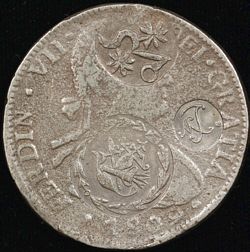
Morelos, Supreme Junta & Lva mint casting stamps
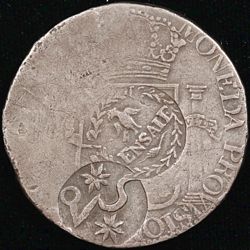
Zs 1811 8 reales with Morelos & Ensaie counterstamps
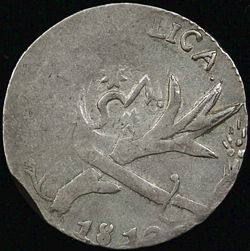
Zongolica 1812 8 reales with Morelos counterstamp
Morelos counterstamp, 1811 – 1813
Morelos also used the same punch design to counterstamp provisional/necessity issues within his jurisdiction. This is one of the most commonly encountered counterstamps. Due to Morelos’ southern location his counterstamp is encountered on a wide variety of provisional coins while the Supreme Junta’s contemporary counterstamp is only encountered on northern hosts. It appears that this counterstamp was not used after 1813 since it is unknown on hosts dated 1814 or later.
Vicente Beristáin, Mid-1812
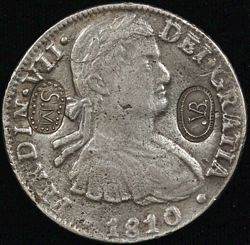 Vicente Beristáin’s casts contain two stamps, S.M. and .VB., each in an oval border, indicating the source and location of their production. Beristáin was an insurgent commander in the state of Puebla, under the command of Osorno. On 23 April 1812 Beristáin attacked the Royalist mining town of Pachuca and captured 164 bars of silver. Reportedly 30 bars were sent to the Supreme Junta under Rayón and 108 bars were reserved for Morelos. Under the order of Osorno, Vicente Beristáin was instructed to cast the bars into money. This was done at Osorno’s foundry in the village of San Miguel Tenango near his headquarters at Zacatlán. For a great in depth look at the history of this issue and its attribution see Ralf Böpple’s Misattributed and overlooked: a rare necessity issue is looking for its rightful place among the Mexican War for Independence issues.
Vicente Beristáin’s casts contain two stamps, S.M. and .VB., each in an oval border, indicating the source and location of their production. Beristáin was an insurgent commander in the state of Puebla, under the command of Osorno. On 23 April 1812 Beristáin attacked the Royalist mining town of Pachuca and captured 164 bars of silver. Reportedly 30 bars were sent to the Supreme Junta under Rayón and 108 bars were reserved for Morelos. Under the order of Osorno, Vicente Beristáin was instructed to cast the bars into money. This was done at Osorno’s foundry in the village of San Miguel Tenango near his headquarters at Zacatlán. For a great in depth look at the history of this issue and its attribution see Ralf Böpple’s Misattributed and overlooked: a rare necessity issue is looking for its rightful place among the Mexican War for Independence issues.
As a side note, it seems that Osorno was in no rush to deliver the bars “reserved” for Morelos. Considerable friction arose and it was not until November of 1812 that delivery was finally completed.
Julian Villagran, 1812 – mid-1813
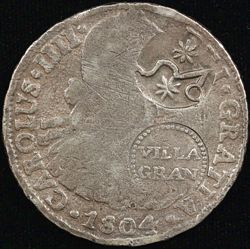 Villagrán mint casting stamp with Morelos counterstamp
Villagrán mint casting stamp with Morelos counterstamp
The colorful insurgent commander Julián Villagrán rose in arms as soon as Hidalgo started his revolution and by 1812 controlled a large area on the east coast above Veracruz. He was as much a highwayman and bandit as he was a revolutionary leader. He proclaimed himself Julian I, Emperor of the Huasteca, the indigenous Indian tribe, and created a palace in Zimapán. Villagrán had bullion but needed species to pay his troops and for supplies. Hence, he created a cast coinage, always with a Mexico City host, and applying his mint stamp as the final step in the process before release for circulation. Villagrán’s mint casting stamp consists of his name in two lines encircled by a border of dots. It is only found as a mint casting stamp and not as a valid counterstamp. All Villagrán counterstamps that I have seen are, in my opinion, fakes.
In April 1813 Julián’s son, Chito, was captured by the Royalists who tried to use him as a pawn in negotiations with the “Emperor”. Julián refused to submit and exhorted his son to die with dignity. Julián himself was later betrayed and executed at Huichápan in June 1813.
